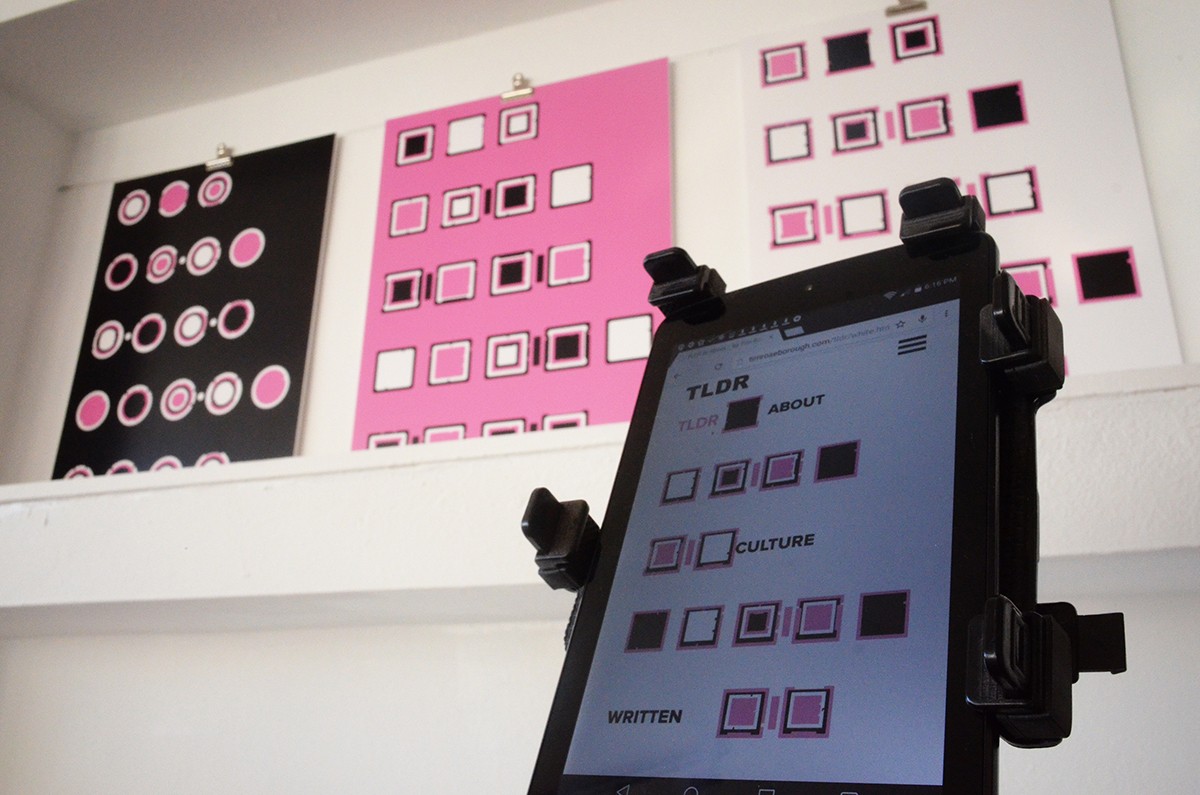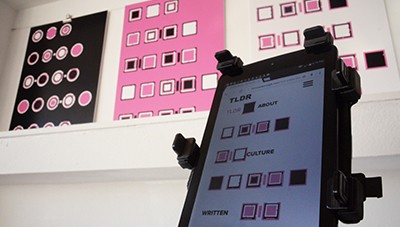On a quiet Saturday afternoon on the outskirts of Downtown Oakland’s Chinatown, co-curator Joanna Cheung met me in person at B4BEL4B gallery to discuss an exhibition that peers into the digital world: TLDR (Too Long; Didn’t Read). The title is cleverly apropos considering that, rather than merely looking, the show frequently requires viewers to read.
The popular acronym is often used on social media to say a piece of writing is far too lengthy to be worthwhile. To some, it may trigger visions of a networked culture accustomed to headlines that are 140 characters, appearing amidst the wide array of content that bombards our social network feeds. But those who shun digital technology for creating a dependence on screens that prevent eye contact, divert our attention from our surroundings, and reduce us to passive consumers may be pleasantly surprised by the works in this show. From iconography to remnants of a robot making spontaneous drawings, TLDR uses language as a delightful medium to explore how digital culture has influenced the evolution of written language. In doing so, it begs the question: how can video, sound, gesture, and drawing function as a form of communication?
Cheung and her co-curator Pierre Forcioli-Conti highlighted work that explores how mobile and digital technologies are changing the ways we effectively communicate emotions and desires, while also showing how we may miscommunicate and misunderstand. They were inspired by artworks that use computer language to produce human language. Take, for instance, a marker-wielding machine that draws what its maker requests. “These two forms are so different semantically, syntactically, and emotionally,” said Cheung. “I thought the juxtaposition between using something so rigid and binary to produce something very fluid and vulnerable was interesting.”
When the curators envisioned the show, B4BEL4B was a natural fit. The venue is one of the few Oakland art spaces that showcases work focused on new media. As a Bay Area-based curator, I was thrilled to partner with the space earlier this year for a show I curated titled Archive Fever that focused on our collective compulsion to document, save, and archive the world around us. Along with each show, the founders of the space run the Emergent Media Lab (EML), which hosts free public programming associated with each exhibit. Whether it’s a drag performance, projection art, experimental electronic music, or learning how to draw with machines, the lab offers a thrilling perspective into the Bay Area digital art scene.
For TLDR, which is on view through October 2, Benedikt Gross and Joey Lee’s “Aerial Bold” dominates the space, consisting of large prints on shin-high platforms that viewers peer down at from above. The images are satellite photographs of architecture, natural formations, and suburban landscapes that inadvertently form letters when seen from a bird’s eye view: A factory building shaped like a B; a block of townhouses that form a D. Gross and Lee crowdsourced photos and screenshots of letterforms from above by taking submissions from the public. Then, with help from Ankita Agrawal of the Institute for Artificial Intelligence, they developed code that allowed a computer to identify and classify the letters on its own, effectively transforming the global landscape into a visual language.
Across from the large letterforms, Lauren McCarthy’s “Conversacube” sits on a plinth. On both sides of the silver box, randomly programmed text appears on the screen, offering phrases intended to facilitate conversation. In one instance, “DANCE” appeared on one side while the other side read “ASK ABOUT KIDS.” With a simple box, McCarthy makes a potent critique of our reliance of devices, while also intriguingly teasing out the complexities (and sometimes awkward nature) of human interaction.
Tim Roseborough’s piece “Retiring Words” employs a character-based system inspired by and created from the English language: Englyph. The patterns may seem foreign, but the system itself is a puzzle to be solved. This compelling work was derived from derogatory words such as “faggot,” “tranny,” and “half-breed” — words that the artist hopes will reach their demise as language and cultures shift and change. For the physical show, he translated the words into Englyph and presented the forms against a pink background. The online component presents the viewer with what, at first, appears to be innocuous and well-designed patterns against a pristine white backdrop. But decoding reveals insidious words that breed and perpetuate oppression — uncovering the violent potential of viral language to disseminate hate.
Gelare Khoshgozaran’s video “Why” offers a global perspective of how algorithms work by showing what autofills Google offered when the artist entered “why” followed by the name of a country. For example, “why italy,” produced “was the birthplace of the renaissance,” “entered ww1,” “wears blue,” “is the best country in the world,” “joined ww2,” “joined ww1,” and “invaded ethiopia.” The autocomplete results revealed a collective consciousness with fears and desires on a global scale. The popularized searches speak to histories that are far more complicated and culturally significant than the few words produced by the engine — just as the acronym “TLDR” encapsulates cultural shifts far more fluid and nuanced than its four-letter signifier lets on.
TLDR proves language is evolving in ways that provoke us to read between and around the lines. Upon leaving, perhaps you’ll become more aware of what you type in your search engine, start looking for letter forms on your next flight, or begin bringing awareness to words that perpetuate hate. And perhaps, as reading takes on new meaning, content might not seem too long to read after all.















